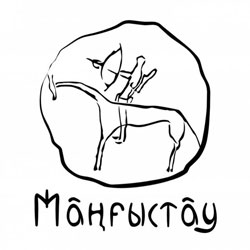Mangystau oblast

Мой Казахстан
Mangystau oblast

Geography
It is located east of the Caspian Sea on the Mangyshlak plateau (Mangystau), bordered in the northeast by Atyrau and Aktobe oblasts, in the south by Turkmenistan and in the east by the Republic of Karakalpakstan as part of Uzbekistan. It is an industrial region where 25% of Kazakhstan’s oil is extracted (almost 20 million tons), and the Aktau — Zhetybai —Uzen oil pipeline passes. In addition, in the Mangystau oblast there is the “sea gate” of Kazakhstan — Aktau city. The northern part with extensive salt marshes is located on the Caspian lowland, the southern part is occupied by the Mangystau Mountains (Otpan, 532 m), Ustyurt plateau, Mangyshlak and Kenderli-Kayasanskoye (in the south). Several depressions lie below sea level, including the lowest point in Kazakhstan — the Karagiye depression on the Mangyshlak peninsula — -132 m.
Relief
Most of the territory of the region is occupied by a sagebrush-saline desert with patches of shrubby vegetation on brown soils: the surface is partially covered with salt marshes, takyr white alkali and sands with extremely rare vegetation.Hydrography
From the west, it is surrounded by the Caspian Sea — the coast protrudes in the west in the form of the Mangyshlak peninsula with deep gulfs of Dead Kultuk, Mangyshlak, Kazakhsky, Kenderli. There are Seal Islands in the Caspian Sea.Climate
The climate is extremely continental and extremely arid. The average temperature in January is -7°C, in July +27°C (on some days the maximum temperature exceeds +40°C). About 100-150 mm/year of precipitation fall.History
Archaeologists have found numerous Paleolithic monuments on the coast of Sarytash Bay, on the Tyubkaragan Peninsula and in the valleys of Shahbagata and Kumakape Rivers[3]. The Shakpak-ata site industry (proto levallua-acheul) on the territory of Fort-Shevchenko city administration has similarities with the tools of the Oldowan culture, the Shakpak-ata site industry (levallua-acheul I) corresponds to the middle Acheul.There is a Neolithic settlement on Kulaly island in the Caspian Sea.
The Neolithic/Eneolithic era includes the Koskuduk I site on the shore of the Caspian Sea (the end of the V — the first half of the IV millennium BC), the industry of which has both archaic types of tools of the Oyukli culture and materials of the Shebir type of the Khvalyn culture. The human burial of the Eneolithic era at the Koskuduk I site is the oldest in Kazakhstan. In the V millennium BC, the Oyuklin culture was replaced by the Tuluz culture.
In the 1st millennium BC, the Great Silk Road from Khorezm and Khiva to Europe and the Middle East passed through the lands of Mangystau. On the Ustyurt plateau along this route there were fortresses, caravanserais, settlements of artisans, cattle breeders and hunters. Archaeological finds indicate that there was a fairly high standard of living in the fortresses and in these settlements. The Great Migration of peoples and the countless wars associated with it interrupted the Great Silk Road through Ustyurt, and the Mongol invasion finally buried and erased its attributes from the face of the earth.
The Altynkazgan religious and burial complex dates back to the VI—I centuries BC. The trade and craft settlement in the Karakabak stow was built by the Khorezmians in the I century BC.
Mangystau has moved to the very edge of the Eurasian ecumene for many centuries. The Mangyshlak peninsula was first mentioned in the IX century under the name Siyah-Kuh (“Black Mountain”) by the Arab geographer Al-Istakhri, who wrote: “I do not know of any other place in that region where anyone lives, except perhaps Siyah-Kuh, where a tribe of Turks lives; they recently settled there because of the enmity that arose between the Guzs and them.” Another mention of the existence of a settlement on the Mangyshlak peninsula is associated with the name of the Seljuk sultan, Alp-Arslan, who in 1065 forced the Kipchaks of the Mangyshlak fortress to resing them to his control.
Mangyshlak Fortress (Kaz. Mangystau), which existed in the X—XIII centuries as a major trading post, it gave its name to the entire peninsula; its exact location is unknown, presumably it was located on the site of the Kyzyl-Kala settlement (now archaeological research is being conducted there). The Kozgantas settlement dates back to the X—XIII centuries. The Horde port settlement of Ketikkala (Ketik-Kala) existed on the Mangyshlak peninsula in the XIV century.
In 1882, Mangyshlak Uyezd was formed as part of the Russian Empire from the Mangyshlak bailiffship, which had existed since 1868.
In June 1920, Mangyshlaksky Uyezd together with the 4th and 5th Adayevsky volosts of Krasnovodsk Uyezd formed Adayevsky Uyezd, which in October of the same year was transferred to the Kirghizskaya (Kazakhskaya) ASSR.
The economic development of the region was due to the discovery of the richest deposits of uranium and rare earth elements, oil and gas by geologists in the early 1950s in the depths of Mangystau oblast. The average salary was the highest among the regions of Kazakhstan in the period from 1996 to 1997. In some years in the period from 1998 to 2002, unemployment in the region exceeded 10% (the first place among the regions of Kazakhstan). By the beginning of the XXI century, the region had the largest share of taxes, fees and payments among the regions. Now the region is one of the most prosperous in Kazakhstan, immigration population growth has been increasing in recent years.
Administrative division
The region is divided into 5 districts and 2 cities of regional subordination:1. Beineu district — Beineu
2. Karakiyansky district — Kuryk
3. Mangystausky district — Shetpe
4. Munailinsky district — Mangistau
5. Tupkaragansky district — Fort-Shevchenko
6. Aktau city
7. Zhanaozen city
Initially, in 1973, the region was divided into 3 districts: Beineu, Yeralievsky and Mangyshlaksky. In 1980, the Munailinsky district was formed, but in 1988 it was abolished. In 1992, the Tupkaragansky district was formed, and a year later the Yeraliyevsky district was renamed Karakiyansky. In 2007, the Munailinsky district was restored.
Contacts



